
HMAS Vampire was a V-class destroyer of the Royal Navy (RN) and Royal Australian Navy (RAN). Launched in 1917 as HMS Wallace, the ship was renamed and commissioned into the RN later that year. Vampire was loaned to the RAN in 1933, and operated as a depot tender until just before World War II. Reactivated for war service, the destroyer served in the Mediterranean as part of the Scrap Iron Flotilla, and was escorting the British warships HMS Prince of Wales and HMS Repulse during their loss to Japanese aircraft in the South China Sea in December 1941. Vampire was sunk on 9 April 1942 by Japanese aircraft while sailing with the aircraft carrier HMS Hermes from Trincomalee.

HMS Terror was an Erebus-class monitor built for the Royal Navy during the First World War in Belfast. Completed in 1916, she was assigned to the Dover Patrol where her primary duties involved bombarding German targets on the coast of occupied Belgium, particularly at the ports of Zeebrugge and Ostend. In October 1917 Terror was hit by three torpedoes, taking severe damage to the bow and had to be towed into Portsmouth for repair. In April 1918 she participated in the Zeebrugge raid and provided gunnery support for the Fifth Battle of Ypres in September of the same year.
Four ships of the British Royal Navy have been named HMS Gnat after the insect.
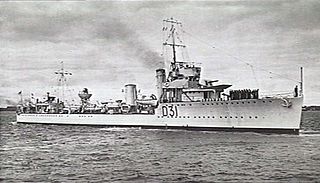
HMAS Voyager (D31/I31) was a W-class destroyer of the Royal Navy (RN) and Royal Australian Navy (RAN). Commissioned into the RN in 1918, the destroyer remained in RN service until 1933, when she was transferred to the RAN. Recommissioned, Voyager served in the Mediterranean and Pacific theatres of World War II until 23 September 1942, when she ran aground while trying to deliver troops to Timor. The ship was damaged by Japanese bombers while trying to refloat, then was scuttled by her crew.

The Insect-class gunboats were a class of small, but well-armed Royal Navy ships designed for use in shallow rivers or inshore. They were intended for use on the Danube against Austria-Hungary. The first four ships—Gnat, Mantis, Moth and Tarantula—were first employed during the Mesopotamian Campaign of the First World War on the Euphrates and Tigris rivers.

HMS Aphis was a Royal Navy Insect-class gunboat. She was built by Ailsa Shipbuilding Company, launched on 15 September 1915 and completed in November 1915. She was based in Port Said at the beginning of World War I, served in Romania and then the China Station until 1940. All of her fighting service was in the Mediterranean, taking part in the invasion of Pantelleria and landings in the south of France, returning briefly to the Pacific in 1945. She was scrapped at Singapore in 1947. Her class was intended for shallow, fast flowing rivers and they also proved suitable for inshore operations when her relatively heavy weaponry could be used to support Army operations.

HMSCricket was a Royal Navy Insect-class gunboat. She was built by Barclay Curle and launched on 17 December 1915.

USS Isabel (SP-521), later PY-10, was a yacht in commission in the United States Navy as a destroyer from 1917 to 1920 and as a patrol yacht from 1921 to 1946.
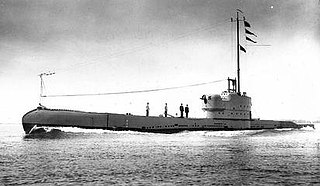
HMS Parthian was the lead boat of the six Royal Navy Parthian-class submarines, all launched in 1929. The submarine was sunk in 1943 during the Second World War. The submarine was nicknamed Peanut, from the identity letters PN painted on the fin.
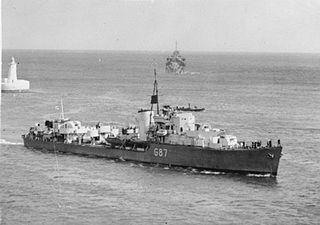
HMS Lance was an L-class destroyer of the Royal Navy. She entered service during World War II, and had a short but eventful career, serving in Home waters and the Mediterranean Sea. She was damaged in two consecutive air attacks at Malta in 1942. She was towed back to Britain, declared a constructive total loss and was scrapped. She had been adopted by the civil community of Bexley and Welling, Kent in November 1941.

HMS Peony was a Flower-class corvette of the Royal Navy. In 1943 she was transferred to the Royal Hellenic Navy as RHNS Sachtouris, serving throughout World War II and the Greek Civil War. She was returned to the Royal Navy in 1951 and scrapped in April 1952.

HMS Tetcott was a Type II British Hunt-class destroyer built for the Royal Navy during World War II. She was the only Royal Navy ship to be named after the Tetcott fox hunt.

HMS Lively was an L-class destroyer of the Royal Navy. She served during the Second World War, and was sunk in the Mediterranean in an air attack on 11 May 1942.
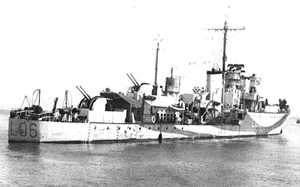
HMS Avon Vale(pennant number L06) was an escort destroyer of the Hunt Type II class. The Royal Navy ordered Avon Vale's construction three days after the outbreak of the Second World War. John Brown Shipbuilding & Engineering Company Ltd laid down her keel at their Clydebank yard on 12 February 1940, as Admiralty Job Number J1569. After a successful Warship Week national savings campaign in February 1942, Avon Vale was adopted by the civil community of Trowbridge, Wiltshire.
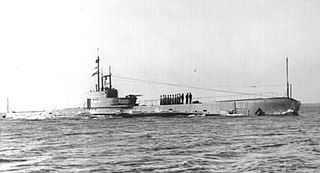
HMS Rover was a Rainbow-class submarine designed and built by Vickers Shipbuilding and Engineering in Barrow-in-Furness for the Royal Navy and was launched on 11 June 1930. During its early career, Rover served in the Far East. During World War II, the submarine operated in the Mediterranean Sea, attacking several Italian convoys and providing assistance to the crippled HMS York during the evacuation of Crete in 1941, before returning to the Far East to operate against the Japanese. The vessel survived the war and was sold for scrap in 1946.

HMS Tarantula was an Insect-class gunboat of the Royal Navy. Launched in 1915, the gunboat saw service in both the First and Second World Wars. Tarantula served with the Tigris flotilla in 1916, retaking a former British gunboat that had previously been captured by the Ottoman Empire. After the First World War, Tarantula was towed to China, joining the China Station, eventually ending up at Trincomalee, Ceylon during the Second World War. After the end of the war, the vessel was sunk as a gunnery target in the Bay of Bengal in 1946.

HMS Osiris was an O-class submarine of the Royal Navy. She was laid down by Vickers-Armstrongs of Barrow-in-Furness on 12 May 1927, launched on 19 May 1928 and commissioned on 25 Jan 1929.

HMS Delphinium (K77) was a Flower-class corvette built for the Royal Navy (RN) from 1940-1946. From 1941 to 1943 she was active in the Mediterranean as an escort to convoys supporting the Eighth Army and the invasion of Sicily. From mid-1943 onwards she was on convoy escort duties between Africa, the Mediterranean and the United Kingdom; and Atlantic convoys between North America and the United Kingdom. She escorted a total of 68 convoys.
HMS Cuckmere (K299) was a River-class frigate of the Royal Navy (RN) in 1943. Cuckmere was originally to be built for the United States Navy, having been laid down as PG-104, but was transferred to the Royal Navy as part of Lend-Lease and finished to the RN's specifications as a Group II River-class frigate. She was first Royal Navy ship to carry the name Cuckmere.

HMS Lagan (K259) was a River-class frigate of the Royal Navy (RN). Lagan was built to the RN's specifications as a Group II River-class frigate. She served in the North Atlantic during World War II.


















